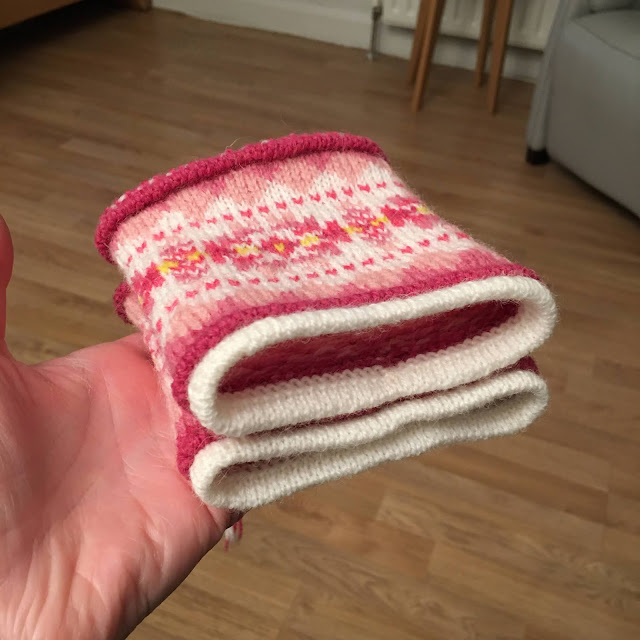Photograph by Alba Turnbull (official wedding photographer - @albaturnbull)
This time last year I was putting the finishing touches to my first commissioned design – a bridal cardigan.
Claire asked me
to design and knit her a cardigan that she could wear on her wedding day and
afterwards, that would represent memories of my Mum, who had died the previous
year before Claire and Karl were engaged. The cardigan was to be knitted in
Shetland wool (my Mum was from Shetland) and was to have specific design
elements. We settled on a minimalistic shape, no buttons, no lace, but with
beautiful shaping that allowed the drape of the fabric to be appreciated. There
were to be fair isle elements (as this was what my Mum knitted).
Since the
cardigan was to be simple and elegant, I decided that statement cuffs in fair
isle would work best. They could stand out as a design feature against the rest
of the garment. They would also complement any flowers but also could be hidden
behind the hand-held bouquet.
Please note that all links to patterns will take you to the company or designer's website (not Ravelry)
I set to work
to identify a pattern that could work for a baseline for stitch count and gauge
and then sourced the best yarn. We chose to adapt the shape of Walpole by
Hannah Fettig for Brooklyn Tweed’s Wool People Vol. 3. All ribbing and textured
stitching was removed, and the cardigan was knitted completely in stocking
stitch. The main body was knitted in Jamieson and Smith Shetland Heritage
(jumper-weight or 4ply)in Snaa White with Jamieson’s of Shetland Spindrift
(jumper weight or 4ply) in Sherbet, Sorbet, Lipstick, Blossom and Mimosa. The
body was knitted in one piece (fronts and back). Sleeves were cast on using a
provisional cast on (adjusting the length to account for the cuffs to be added
later). Sleeve shaping was calculated and the sleeves were knitted in the
round. The body and sleeves were joined, and the cardigan completed at the
neckline. I knitted up the collar on both fronts and kitchener-stitched the
ends together at the back of the neck. This helped me to achieve the seamless
effect that was crucial to the design’s simplicity.
I set to work
to design the cuffs. To create visual impact and frame the fair isle design, I
included double tucks at the beginning and end of the cuff to co-ordinate with
the main body and the fair isle colours.
Using a
photograph of a garment my Mum had designed and knitted in the 1950s, I
extracted an element of the design and created a chart using the number of
sleeve stitches (circumference) and the required length as a guide for the
chart placement. I worked with Claire and the Jamieson’s Spindrift shade card
to identify colour combinations that could work and set to colouring and
swatching a variety of colourways and colour placements for her approval.
We settled on
one design, and I liaised with my aunts (expert fair isle knitters in Shetland)
for their verdict on authentic colour placement - so the colours didn’t fight
with the design. Receiving their seal of approval, I cast on in the round and
knitted the cuffs. I soaked and blocked them around jam jars (the perfect fit)
and prepared to add them to the blocked and finished cardigan. I unpicked the
provisional cast on at the bottom of the sleeves and kitchener-stitched the
stitches of the cuffs to the sleeves.
There was left over yarn and I searched for a shawl pattern that would use a main colour and the various colours included in the fair isle design. I found Liz Corke’s Turadh – a perfect design for the yarn and a shawl that I will certainly knit again.
I was anxious until Claire returned home to try on the finished garment, having worked only from body measurements and measurements of garments that has a similar fit to what she wanted for this design. It fitted well and added a touch of something completely unique to her day – I have lovely memories of designing and knitting the cardigan and remembering my Mum and how much she loved Claire. I hope Clare has many happy memories of wearing it on her special day too.














Comments